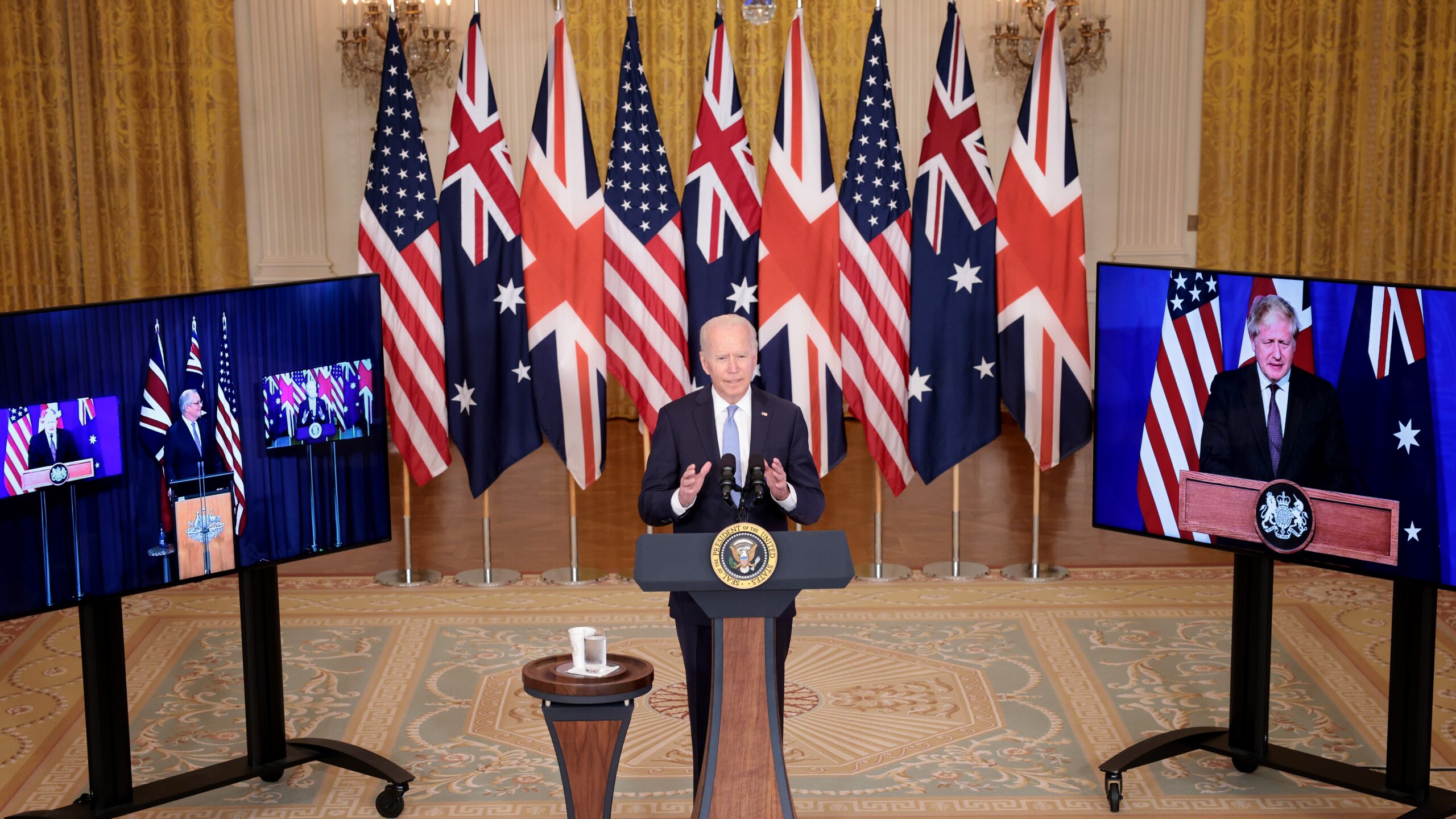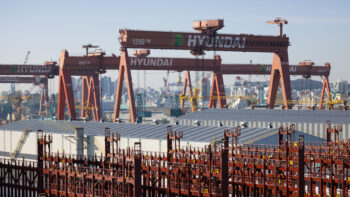
President Joe Biden on Sept. 15, 2021, announced a new national security initiative in partnership with Australian Prime Minister Scott Morrison (L) and United Kingdom Prime Minister Boris Johnson (R). (Win McNamee/Getty Images)
WASHINGTON: The US Space Force and its like-minded counterparts are increasingly eyeing ways to avoid duplicating capabilities, with the American service setting up a series of agreements in hopes of each country bringing its best hand to the fight.
“There may be future architectures for some mission area [where] we get together as allies and say, you know, we’ll concentrate on this piece here in the United States, and maybe the UK agrees to concentrate on this piece, and Australia concentrates on this piece. And together we bring an integrated by design architecture forward,” Lt. Gen. John Shaw, Space Command deputy, said Nov. 17 during a panel discussion at the American Institute of Aeronautics and Astronautics’s ASCEND conference.
Lt. Gen. Nina Armagno, Space Force staff director, elaborated on Shaw’s point, noting that the service already has cooperative development efforts underway via the Space Systems Command (SSC) Partnership Office led by Deanna Ryals.
“We kind of used to think of allied partnership, as: ‘hey, Australia, why don’t you buy the next satellite, if you will?’ Today, we’re talking about getting together from concept, from design and working together on future capabilities and projects,” she said.
“In fact, we’ve signed an MOU with 10 countries,” including the UK and Australia, on “responsive space capabilities,” she added. “We all are looking at collaborating on burgeoning science and technology, research and development needs that we all see could benefit all of our countries as we move forward.”
Partnership Arrangements
That MOU process, which dates back to 2014 “was established to initiate, conduct and manage research, development, test and evaluation (RDT&E) cooperation projects related to responsive space capabilities. Additionally, the RSC MOU allows the exchange of information for harmonizing the participants’ military requirements to assist in defining potential cooperative efforts under the RSC MOU,” Angela Lindemuth, deputy director of SSC’s International Affairs Capabilities Development Division, told Breaking Defense in an email.
Participating countries include Australia, Canada, Germany, Italy, Netherlands, New Zealand, Norway, Spain, Sweden, and Great Britain, she said.
Lindemuth, who serves as lead for activities under the MOU, explained that there currently are four multilateral “Project Arrangements (PAs)” underneath the MOU, although she did not elaborate on which countries participate in which ones. These are:
- Micro-Satellite Military Utility (MSMU) PA: to evaluate the utility, performance, technical feasibility, and potential cost of microsatellite concepts to determine the extent to which military Microsatellite systems can provide a cost-effective replacement or complement to other space assets.
- Military Optical Satellite Communications and Optical Space Data Relay (MOSCOM) PA: to determine the interoperability, benefits, and limitations of evolving optical satellite communications technologies, including data relay and machine to machine interactions.
- Responsive Launch and Range (ReLaR) PA: explore, identify, and assess concepts to reduce the cost of launch and improve the military space launch responsiveness of the Participants to this Project. This ReLaR PA will explore responsive space capabilities-related technologies that may increase the responsiveness of launch operations.
- Low-Light Automatic Identification System (AIS) for Maritime Domain Awareness (LLAMDA) PA: The development of a low-cost non-cooperative space-based maritime surveillance capability using an EO sensor and a micro-satellite approach.
“These are cooperative RDT&E efforts focused on outcomes that explore small, low-cost, rapidly-implemented, space-based solutions to achieve ‘Assured Space Power Focused on Timely Satisfaction of Joint Force Commanders’ Needs’,” Lindemuth said.
Allies Scope ‘Niche’ Capabilities
For its part, the United Kingdom already is turning the country’s military space focus towards bringing “niche” capabilities to the fight, Air Vice Marshall Harv Smyth, Defense Ministry director for space, told the virtual panel. London, he said, recognizes that it can never match DoD’s space capabilities, but instead must strive to “add value” and “bring resilience” to coalition efforts.
“From a UK perspective, we’re doing quite a bit of analysis on just understanding where we have niche capabilities that we could bring to the table and offer goodness,” Smyth said.

For example, he cited the End-of-Life Services by Astroscale demonstration (ELSA-d) by Japanese startup Astroscale, which now has subsidiaries in the UK and US. The UK government licensed that debris removal mission, which launched in March and in August demonstrated the spacecraft’s ability to capture and release a satellite.
Smyth noted that while Britain is trying to build up its own space capabilities, and that somethings will always be “sovereign stuff,” the central idea is to build an architecture and strategy from the ground up to allow interoperability. He said he is constantly advising his UK teammates: “let’s not build an architecture that has a three British three-pin plug and then we’re trying to plug it into a US two-pin socket. That will be an own goal. There’s no reason for us to do that.”
“Australia’s well behind the US and UK, and but we’re rapidly gaining,” said Air Commodore Nicholas Hogan, director general of the Australian Defense Force’s ongoing “space domain review.” He stressed that “interoperability is key” to Canberra’s approach for building up its space capabilities. “It’s one of our design principles.”
Australia’s MoD hopes to release a new “defense space strategy” by the end of this year or early next year, he said, in which “education on the criticality of space and global dependence” will be highlighted. In May, the ministry announced that it also intends to establish its first-ever “space division” under the Royal Australian Air Force early next year.
The US Space Force has been steadily strengthening long-standing space ties to Australia as Canberra has moved to bolster its indigenous capabilities with a wary eye on China. Australia has been of particular interest to DoD as a partner in the space situational awareness (SSA) mission because the US Space Surveillance Network, which includes a number of radar facilities, lacks coverage of the Southern Hemisphere.
Hogan said that one of Australia’s key areas of focus is trying to “scale up” innovative efforts quickly.
Classification Woes Continue
Not everything is perfect, however.
Both Smyth and Hogan pressed politely, but firmly, on the need for the US to reduce classification levels to allow improved information sharing with allies about its space activities, as well as those of potential adversaries.
And while the US has made some progress (as pointed out by Shaw and Armagno) in declassifying information about adversary capabilities, it has pretty much failed to unlock the so-called green door on its own capabilities — despite strong support from senior US military space leaders. Demonstrating the obstacles to doing so, nearly 58% of respondents to Breaking Defense’s first Space Survey said that the US should not declassify more information about its own offensive capabilities.
“The key to success is frank and open discussion … tearing down those information sharing barriers, to be sure that we’re truly interoperable,” Hogan said. “Our three nations are innovating and, at times, I can see that we are duplicating without knowledge of what we’re doing. So greater information sharing helps us … so that we can harness the creativity more efficiently and effectively to outpace our competitors and to shore up access to space.”
“I think alliances is where we have our key strength,” said Smyth, “unlike our potential adversaries like China and Russia, who in many ways are operating alone. But for us to make those alliances work effectively, we must be able to share and we must be able to share meaningfully and at the speed of relevance.”
He noted that historically, US capabilities “have been very highly classified for many reasons, many of which sit in special access compartments.” So the question is “how do we get beyond some of those classifications to start to unravel the challenge of ‘no foreign,’ and to unravel that in a meaningful way?”






















